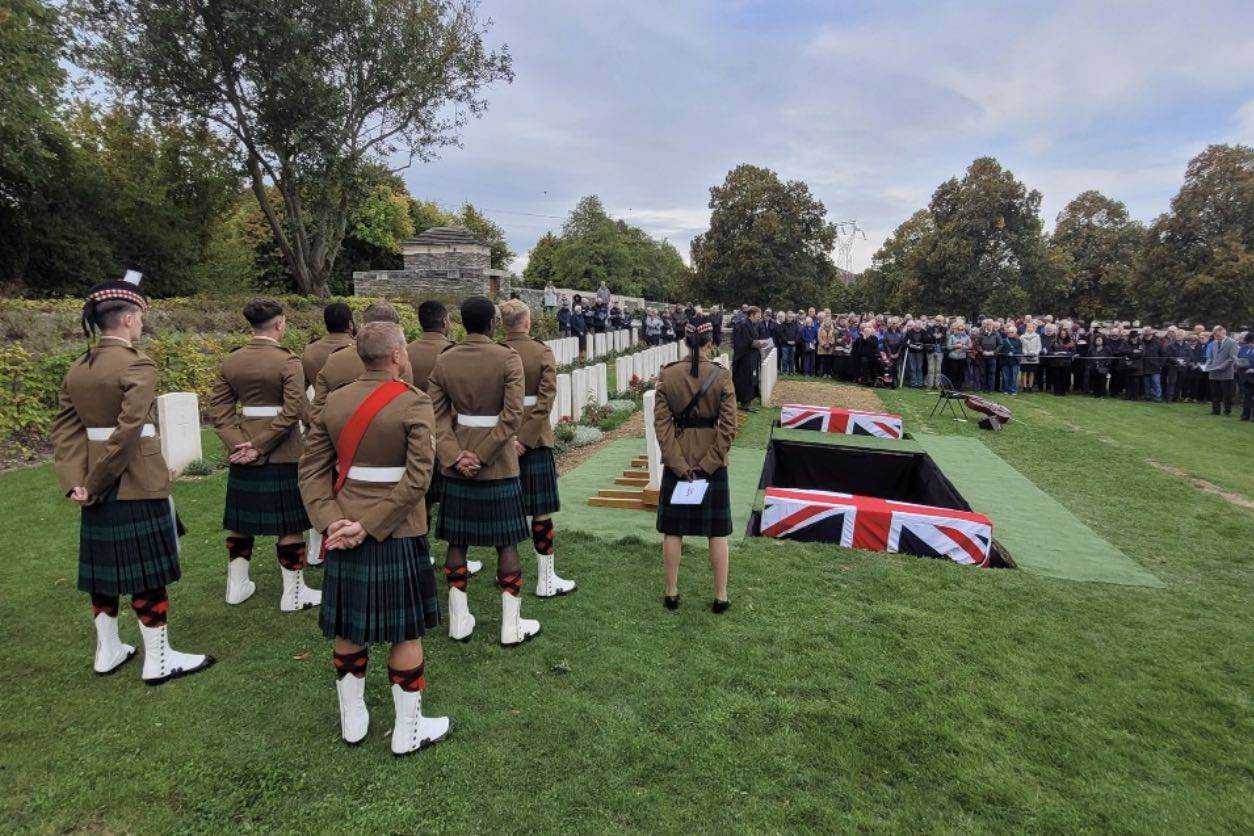


The reinterment took place at the Commonwealth War Graves Commission’s Loos British Cemetery Extension, the very soil upon which so many thousands gave their lives. Serving soldiers from the 4th Battalion of the Royal Regiment of Scotland carried the coffins, while military chaplains presided over prayers and the traditional hymns of remembrance rang out.
For relatives who had long wondered where their ancestors lay, the day marked a moving moment of closure. Nicholas Allan, great-nephew of Lieutenant Allan, said the ceremony had a profound significance: “It speaks to me of all those whose bodies were never found … we’re completing something for them too.” Meanwhile, Alistair McPherson, great-nephew of LCpl McPherson, recalled the vividness of letters he had grown up reading, and added: “He’s no longer lost.”
Lt Allan, once a student at Edinburgh University, volunteered for the 9th Battalion of the Gordon Highlanders at the outbreak of war in 1914. He joined alongside his brother Nimmo. On 25 September 1915, the first day of the Battle of Loos, he was killed in action. A fellow officer’s tribute painted a picture of a well-respected leader:
“Jim’s men thought the world of him … He may have left this world but only to go to a freer one.”
“I have been strengthened by the thought of him…”
LCpl Gordon McPherson, prior to the war a tobacconist, had enlisted in November 1914 into the 7th Cameron Highlanders along with both his brothers. In his section he was known as “the life and soul”, and his impersonations of Charlie Chaplin were reportedly a favourite among his comrades. His favourite song, “Trumpeter, what are you sounding now!”, became a shared refrain among his peers.
The identification of both men was made possible through painstaking detective work. Lt Allan was identified after artefacts found at the site suggested one casualty was an officer; cross-referencing missing-officer records led to his name. McPherson’s identification hinged on a small tramway button in his pocket, traced back to the Newcastle Corporation Tramway as his father worked there. DNA testing of next of kin confirmed the match.
The remains of these soldiers were unearthed during construction work for a new hospital near Lens, in the Hauts-de-France region. Among the remains were others whose identities have yet to be determined. The burial ceremony, organised by the Ministry of Defence’s Joint Casualty and Compassionate Centre (often known as the “War Detectives”), served as both tribute and act of dignified reconciliation with the past.
Nicola Nash, representing the MOD’s War Detectives, remarked:
“With half a million British servicemen still missing from the First World War, every identity we make is a huge achievement. It has been a real privilege to give closure to their families and lay these heroes to rest with honour.”
Jeremy Prince, CWGC France Area Director, noted the symbolism of the timing: the ceremony coincided with the 110th anniversary of the Battle of Loos and underscored the ongoing duty to remember those whose sacrifice lay unmarked for decades.
This reinterment speaks to broader efforts over recent decades to resolve the lingering mysteries of the First World War. As scientific techniques advance and archival records are cross-matched with genealogical data, more soldiers long deemed “missing” may finally be named. Yet even amid technical triumphs, the human dimension remains central: families long bereft of certainty now find themselves at gravesides, offering prayers and tears.
The act of burial with ceremony and full military honours is more than debt-paying: it is a recommitment to the ideal that no sacrifice should be forgotten. Over time, such acts help knit together local memory, national history, and the sense of continuity between past and present.
For Scotland, in particular, the presence of these Highland regiments at Loos recalls a tradition of martial service, of men called from peacetime civilian life into the maelstrom of industrial war. Their stories, once fragmentary, have now found voice again.
In the grand sweep of history, the reburial of eight Scotsmen may seem a modest footnote—but to their kin, it is profound. In an era when the centenaries of the First World War are passing into living memory, such ceremonies serve as reminders that the costs of conflict continue to echo. For the institutions doing this work—the Government’s War Detectives, the CWGC, the regiments involved—it is a moral calling as much as an archival exercise.
On fields that once echoed to gunfire, the silence now is full of tribute. The small graves with their uniform headstones stand as testament to service, loss, and the persistence of remembrance. And for those families who held hope across a century, watching service personnel lower the flags and echo the volleys, this is at long last a moment of reckoning, a moment when the missing are named—and the dead are finally, respectfully, at rest.